Anglers are drowning in gear choices—rods, reels, boots, waders, lines, packs, bags, boxes, vests, apparel and more. It seems harder and harder to know what's worth coveting and what's worth ignoring. Gear reviews are a great way to explore in-depth what might be right for you, but not every piece of gear is suited to a full-length review and, even if it were, there's simply too much of it to get to. With that in mind, we periodically showcase what's working for us right now, to hopefully offer more helpful feedback on gear that's worthy of your attention.
All gear is welcome here: new, old, cheap, pricey, and so on.
The goal is to provide useful feedback on gear that works—not to help gin up marketing for new products. Sometimes, great gear has just hit the market, other times it's been here doing good work all along.
As always, our feedback comes with a promise: Unlike many magazines that publish gear roundups for products they've never so much as seen in person let alone put to work, we've actually used and field tested every piece of gear we write about.
Hedgehog Octopus Black Ionic i3 Dryer
If you’re like me, you habitually leave everything to the last minute. Things like giving your wading boots a good scrub and rinse before stashing them in your luggage. It was a task that was partially intended to avoid seasoning everything else living temporarily in that same bag with a layer of dried mud but also motivated out of respect for the faraway fishery I was headed to — some small effort to reduce the likelihood that I’d tote along invasive species or other unwanted guests with me. Unfortunately, by the time I decided to cross this item off my pre-departure TODO list, the trip was only a couple of days away.
At less than an hour to go before my flight, my wading boots seemed like they were still as soaked as they had been when I’d finished cleaning them two days prior. There wasn’t any more time to delay packing. They were going to have to get tossed into a trash bag and transported wet. That is, until I remembered that I’d had the odd-looking Hedgehog Octopus (pictured at top) — a gear dryer aimed at all kinds of outdoor gear, not specifically fishing gear — shipped in a couple months prior with plans to break it out and see if it was any good once winter fishing kicked into high gear. The Hedgehog had, if I wanted to really push it, 35-40 minutes to get my boots from still-soaked to bone dry. And surprisingly, it did. With plenty of time to spare.
Easy to hang with its included hook or mount directly on the wall with its included wall anchors, the lightweight Hedgehog is also easy to transport. It’s also dead-simple to use with intuitive controls for both temperature and run time. With the aforementioned winter fishing season ahead, not to mention ski season — both full of wet gloves, mittens, balaclavas, buffs, boots and more — during which having dry gear is not just a matter of comfort but safety, the Hedgehog seems poised to get a great deal of use.
— Chad Shmukler

G. Loomis NRX+ Swim Fly 8’8” 7-weight
There are times when I’ll happily reach for a 9’, 9’6” or even a 10’ streamer rod. If my day on the water is built around long casts and swings, with the goal of covering as much water as possible, those rods excel. These days, however, the majority of my streamer fishing doesn’t fit that mold. More commonly, I’m fishing streamers relatively up-close-and-personal. Whether I’m on a walk-and-wade mission, fishing sculpin patterns quartered upstream or operating out of a boat, targeting pockets along the bank or fishy lies in woody structure, where hitting spots (often amongst tight cover or obstructions) with accuracy and in rapid succession is the name of the game, longer rods can become a bit of a liability. For this reason, I’ll seek out a shorter rod (sub 9’ long) for those outings.
Loomis built its Swim Fly series — which features just two models, a 7-weight and an 8-weight, both 8’ 8” — specifically for these scenarios. Four inches might not sound like much, but that reduction in length translates to quicker line pickups, quicker rod loading and, most importantly, a much more instinctive connection between my arm and my fly rod. I’ve put the NRX+ Swim Fly 7-weight through its paces on multiple fisheries and each time I’ve fished it, my “hit rate” has gone up noticeably vs. when fishing longer rods. True to the NRX+ series as a whole, the Swim Fly is powerful and accurate. Most importantly, it gets out of the way, offering confident control, letting me focus on delivering the fly rather than letting worries like lifting heavy flies, carrying heavy sink tips, or putting a size 1 stinger hook into my boat partner’s ear creep into my mind.
— Chad Shmukler

Scientific Anglers Amplitude Smooth Infinity Line
I’ve been playing around with a variety of fly lines over the last year or so, as part of an effort to make sure I was getting the best performance out of my fly rods. For a few months, I switched over to the Mastery Trout Standard line from Scientific Anglers, and I’ve spent time throwing some 406 Classic lines, as well. I even busted out a few double tapers, looking for the perfect line/rod pairings. At the end of this experiment, however, I landed right back where I started: spooling up the Amplitude Smooth Infinity line from SA.
This line is a half-weight heavy, so it works best with stiffer, faster rods, but even on softer rods (like a 5-weight Winston BIIIx) it has a long enough head, with a delicate enough taper, to coax the best performance from a variety of sticks. On the 5-weight, the head is 49 feet long, which makes for excellent and easy mending. That I’ve come back to this line after more than six months of experimenting with other options speaks volumes to how well it works on everything from my Orvis Helios (the new one that they insist isn’t the Helios 4) to the Scott Session, to the Thomas & Thomas Avantt II.
— Spencer Durrant
BUY SA AMPLITUDE SMOOTH INFINITY

YETI Roadie 15 Cooler
YETI’s venerable Roadie has gone through a few iterations over the last decade or so, with the latest round of revisions and (hopefully) improvements making their way into the newest member of the family, the YETI Roadie 15. YETI remade the classic Roadie 24 a few years back, introducing a whole host of improvements, most notably its new Quick Latch closure and the cooler’s wine bottle compatibility. In the new 15 liter Roadie, YETI has carried over those improvements while simultaneously addressing the 24’s only memorable shortcomings — the inexplicable decision to ditch the drain plug and the clumsy handle.
There’s not much to say about the drain other than I sorely missed it, knocked YETI for pulling the plug (yeah, yeah) last time around, and am thrilled to see it return. The Roadie 24’s handle, which I was skeptical about when I initially reviewed it and have come to view as a design flaw in the time since (too short, plagued by the grip cover repeatedly coming off), has been replaced by a wonderful new handle system that is not only comfortable but adjustable. I’m looking forward to seeing these improvements make their way into the 15’s bigger family members.
Lastly, it’s worth noting that the Roadie 15, despite being a hard cooler, is seriously portable, leaving me wondering whether my Hopper Flip is going to start collecting dust.
— Chad Shmukler

Skwala Fusion 3/2 Puffy
Another piece of gear that does its job so well partially by getting out of the way, Skwala’s Fusion 3/2 Puffy is one of the best insulation pieces I’ve worn in years. Skwala bills the 3/2 as a serious piece of cold weather insulation, and it is, but it also deserves accolades for how versatile it is. The 3/2 Puffy is warm when you need it to be but breathes so well that you’ll be far less likely to need to strip it off when the cold bite eases up than you will with similar insulation layers that provide the same level of frigid weather comfort. In signature Skwala fashion, the 3/2 fits snugly but stretches and moves with you, meaning you can enjoy its reduced bulk without sacrificing range of motion. The 3/2 is also notably good at shedding water, which also means you can keep the rain jacket at bay a bit longer when it’s not coming down too hard.
With an unseasonably cold late fall season upon us here on the east coast, the 3/2 has also become a daily driver, as it is equally at home — and a very welcome companion — both on the water and on cold morning walks to throw the ball for the dog.
— Chad Shmukler

Orvis Mirage LT Reel
I’ve never thought much about the reels I use for trout fishing, because for most trout fishing, a reel is nothing more than a fancy line holder. Sure, some folks put a 15-inch trout on the reel, but you don’t need to. A trout reel with a drag that can stop a freight train is overkill and a classic example of fly anglers falling prey to effective marketing.
But when you’re chasing big trout with big flies in big water, you need a reel that’s up to the job. And more important than stopping power is the reel’s startup inertia, or lack thereof. Startup inertia is the fancy term for how much of a hitch, or jerk, you feel when pulling line off the reel. A reel with low startup inertia is smooth and that smooth movement better absorbs the shocking runs of big, angry trout.
That’s where the Orvis Mirage LT shines. I’ve had this reel for years and have used it on everything from trout to salmon to Dolly Varden, but it wasn’t until this summer that I truly appreciated just how great it is. The Mirage LT is the smoothest reel I own — better than any of the modern reels in my collection — and it’s my go-to choice for big trout. My local tailwater is big, deep, and fast, and the trout are fat; a four-pound trout in heavy current can put a reel to the test, and the Mirage never falters. Even when I crank the drag down tight, it’s still as smooth and strong as the trout it’s trying to stop. I cannot recommend it highly enough.
— Spencer Durrant

Hardy Ultralite X fly rod
I don't fall in love with fly rods easily. So many are so alike. Everything is stiff and fast and … all those damn letters and numbers that (hint to every fly maker anywhere) mean absolutely nothing to the average fly fishers but apparently mean everything to corporate marketing teams are just exhausting. The Hardy Ultralite X (one useless letter!) is one of the rods I don't think I could live without. First, the “Ultralite” part is spot-on. I have 9-foot 5-weight, and in just over a year, this rod has elevated itself to “daily driver” status over some rods that you might think would perform better. They don't. The Ultralite X is seriously light. Less than 2 ounces light. It casts like a dream and it possesses a backbone that I'd stack up against the rest of the premium rods in its class. If you're keen to drop a grand or more on a fly rod, the Ultralite X has my complete endorsement. You won't be sorry.
— Chris Hunt
Smith Hookset Sunglasses
The new Hookset frames from Smith Optics have quickly become my go-to. The Hooksets are a nice medium-sized frame that don’t dominate your face, and they feature the best leash retainer I’ve ever used. Smith calls it the PivLock, and it attaches to your sunglasses without adding any bulk. As someone who wears hearing aids, I appreciate how slim these sunglasses are, even with the leash attached.
The lenses I like are the ChromaPop Glass PolarChromic Brown Green Mirror. Yes, that’s a mouthful. It’s a marriage of Smiths’ ChromaPop polarization technology, and PolarChromic lenses that adjust the tint based on how much UV light hits them. So, in low-light situations, the lenses will lighten. On bright days, they’ll darken. These lenses will allow anywhere from 11% to 20% of visible light through, depending on how much UV light hits them. It’s not a gimmick, and the lenses have worked well for me in Alaska, Wyoming, Montana, and in countless different weather conditions.
— Spencer Durrant










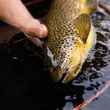

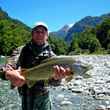
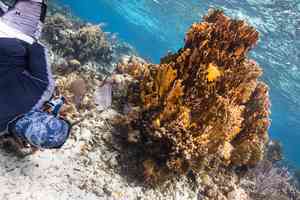








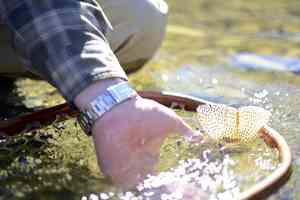
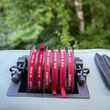
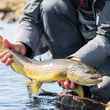

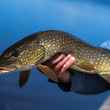

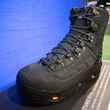

Comments